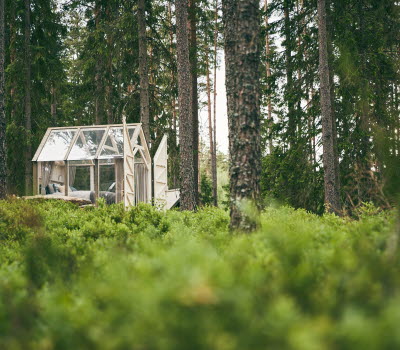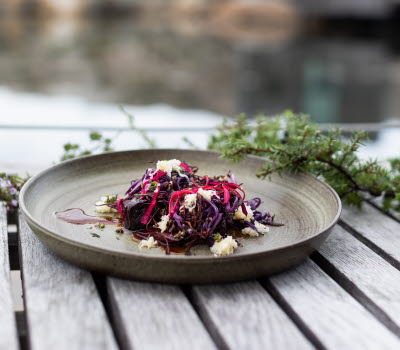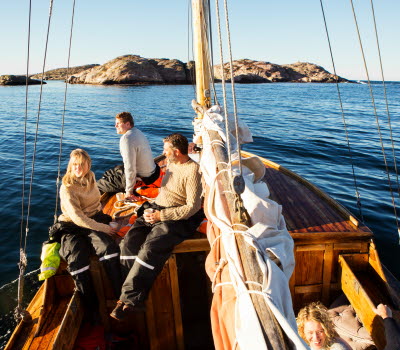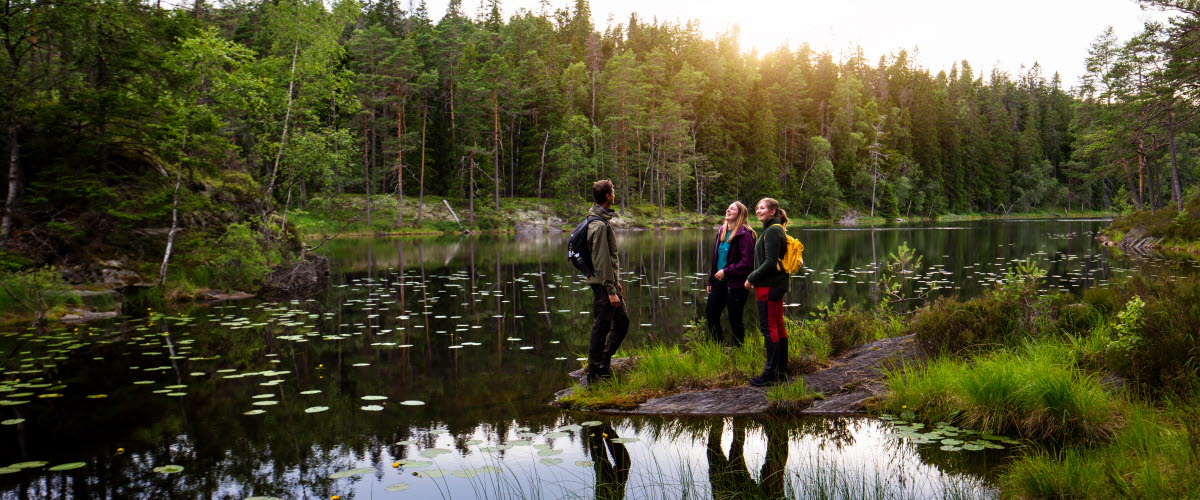Discover West Sweden’s four National Parks
There are four National Parks in West Sweden: Tresticklan, Kosterhavet, Tiveden and Djurö. Each has a very different character but what connects them all is that they offer epic nature experiences.
Altogether there are around 30 National Parks in Sweden and four of them can be found in the West Swedish region of Västra Götaland. The possibilities are endless for anyone who likes to hike, cycle, paddle or be outdoors in any other way.
1. Tresticklan National Park
If you’re after a true wilderness feeling then Tresticklan is the right place to head to. The National Park is in the municipality of Dals-Ed in Dalsland, right by the Norwegian border, and boasts one of southern Sweden’s largest forested areas with no roads or settlements.
The surroundings are best explored on foot. There are three main walking trails to choose from: Bråtaneleden, Bodalsvikenleden and Orshöjdsleden. Fill your lungs with fresh forest air and prepare yourselves for a hilly hike among twisted pines, rocky ridges and small lakes.
Beautiful views, cloudberries and chanterelles
The outstanding view from the national park’s highest point, Orshöjden, 276 metres above sea level, is not to be missed. Along the route you’ll pass many old crofts, some inhabited as long ago as the 1600s. The area is also rich in cultural heritage, like the mica mine by Lake Stora Pylsan and the Orre-Bryngels cave.
Between the longitudinal ridges lie lakes and marshland where cloudberries, orchids and dwarf birches grow. Wood anemones flower here in spring and in autumn you’ll find plenty of wild mushrooms.
Moose park and guided walks
Why not stop and say hi to the moose at Dalslands Moose Ranch in Ed, just 20 minutes by car from Tresticklan. They also provide accommodation and guided walks in the national park. Other places to stay in the area include Vita Huset by Lake Stora Le in Nössemark, or Hotell Dalsland and Gröne Backe Camping in Ed.
How to get there
Tresticklan is most easily reached from the eastern entrance signposted along the road between Ed and Nössemark, about 2.5 hours by car from Gothenburg. There are information boards in the car park about the flora and fauna in the park, its topography and the hiking trails.
The nearest bus stop is Rävmarken, four kilometres from the park entrance. The bus departs from Ed which you can reach by train or bus from Gothenburg.
2. Kosterhavet National Park
Kosterhavet is no ordinary national park. One of Sweden’s two known occurrences of coral reef exist here and many animal and plant species not found elsewhere in Sweden thrive in the salty waters. Porpoises are occasional visitors. The area also includes many small islands where you can spot common seals basking in the sun.
In the middle of the park lies the Koster Islands, one of Sweden’s sunniest places and a true holiday paradise where you can hike, cycle, kayak, snorkel, go fishing and much more.
Home for 12 000 species
Kosterhavet is Sweden’s first marine national park and as in the myth of the magical underwater world of Atlantis, Kosterhavet’s glories are to be found under the surface. In total there are around 12 000 species in the area, both on land and in the water. Many of the rarer species exist in the Koster trench, which runs through the national park from north to south, with a maximum depth of 247 metres.
Kust Event and Selin Charter offer guided boat trips where you can, among other things, try your hand at prawn trawling, look for seals, and meet the lighthouse keeper on Ursholmen. If you want to be nearer the water you can hire kayaks or book a guided paddling tour with Koster Adventures, Koster Kayak Tours and Skärgårdsidyllen.
Photographer: Roger Borgelid
Naturum is the main entrance to Kosterhavet
At naturum Kosterhavet visitor centre on Sydkoster there’s an interactive exhibition, maps of the hiking and snorkelling trails, knowledgeable guides who arrange excursions and a petting aquarium where you can get up close to starfish and several other of Kosterhavet’s animals. Entry is free.
Take the opportunity to visit Kläpphagen for lunch. Other nice accommodation back on the mainland is Daftö Resort, Lagunen Camping & Stugor, Strömstad Spa and Seläter Camping.
How to get there
The national park is in the municipality of Strömstad and Tanum and is connected to the Ytre Hvaler National Park in Norway. There are several entrances: Saltö, Rossö, Resö, Strömstad and Sydkoster. A good place to start is the main entrance, naturum Kosterhavet in Ekenäs harbour on Sydkoster. Kosterbåtarna depart regularly from Strömstad’s north harbour to Ekenäs, a journey of around 40 minutes. You can easily get to Strömstad in around 2-3 hours by train, bus or car from Gothenburg.
3. Tiveden National Park
In between Sweden’s two largest lakes, Vänern and Vättern, lies Tiveden National Park, a paradise for anyone who loves wilderness adventures. Several walking trails wind through the area, from 1 to 9 kilometres long. Some patches of the longer trails go through challenging terrain.
Tiveden is definitely one of Sweden’s most beautiful national parks. The surroundings look as if they’ve come straight from a John Bauer painting, with deep rock crevices and gigantic blocks of stone covered in deep green moss. The area has several small forest lakes perfect for swimming, fishing or paddling.
Among gnomes and trolls
There can be few natural areas as full of myths and legends as Tiveden. There really is a feeling of enchantment in the forest. Stories about everything from gnomes and trolls to cunning elves and giants throwing huge boulders at each other, have abounded here for centuries. And maybe it’s the myths that have given some of the park’s most well-known places their names: Stora och Lilla Trollkyrka (Big and Little Troll Church), Junker Jägares Sten (Squire Hunter’s Stone), Vitsandsgrottorna (The White Sands Caves), Stenkälla (Stone Cellar) and Stigman’s Pass.
Picnic by a tarn
Time passes quickly when you’re in the great outdoors so before you know it it’ll be time for a fika. It’s not exactly overflowing with restaurants in the area so remember to pack a picnic. There are lots of scenic spots to settle down for a well-earned picnic.
Photographer: Lina Vestman
How to get there
The easiest way to get to Tiveden is by car along route 49 between Karlsborg and Askersund. It’s about three hours by car from Gothenburg. There’s a good InfoPoint in the car park with a map of the walking trails. Unfortunately it’s hard to get to Tiveden by public transport. If you want to stay overnight we recommend Norrqvarn Hotell by the Göta Canal, Braxmaviken Gård or Karlsborgs Camping. Here you can find more accommodations in Karlsborg, a half hour’s drive from Tiveden.
4. Djurö National Park
Djurö is probably one of Sweden’s least well known national parks. It consists of a group of 35 small islands in the Lake Vänern archipelago– completely secluded from the surrounding world. There are no commercial businesses here and no regular traffic, so the only noises you’ll hear are natural ones.
Pine forests, lichens and bilberry bushes are the dominant flora, interspersed with smooth bedrock and glacial pebble beaches. During the summer months the islands attract a number of holiday visitors who arrive by boat to enjoy outdoor life and swimming.
Hike from the lighthouse to the hunting lodge
On the largest island there are three settlements: Fyrplatsen (the Lighthouse Station), Djuröstugan (Djurö Cottage) and Jaktvillan (the Hunting Lodge). In the middle of the island are the remains of a previously farmed area, but nowadays there are no permanent residents on the island. Even the lighthouse is unmanned. A lovely well marked walking trail goes past all the buildings and takes about one hour to walk.
Live like a lighthouse keeper
Djurö used to be a hunting park, where fallow deer, hares and grouse were introduced. The population has declined since then but you can still see fallow deer grazing in the meadows. Some of the smaller islands are bird protection areas with no access allowed from April to July.
If you want to stay over both Djurö Cottage and the Lighthouse Keeper’s House are available to rent. Contact the park management for more information about accommodation rental. Otherwise you’ll find plenty of lovely hotels in Mariestad or Lidköping. Some recommendations are Hotell Vänerport in Mariestad as well as Lugnåsberget Ekohotell and Vristulvens Äventyrscenter which are located just outside Mariestad.
Photographer: Foto: Lotta Samuelsson
How to get there
Djurö lies about ten kilometres from the mainland and is part of the municipality of Mariestad. The islands can only be reached on your own boat or by taxi boat. The easiest place to land is Malbergshamn on Djurö’s nothern coast, where there is a board with information about the islands as well as a waterless toilet and barbecue area.
Taxi boats can be hired in Spiken’s harbour on Kållandsö and in Mariestad. You can get to both places on Västtrafik buses. From Gothenburg it takes around 2-3 hours on public transport or by car. Also, Vänern Outdoor and Laxhall Hamnkrog arrange boat tours to Djurö.
Rules and Safety
Please remember to take care of nature and follow the rules and regulations regarding parking, fires, overnight stays, and so on. Here you can read about the rules that apply in each respective national park:


















